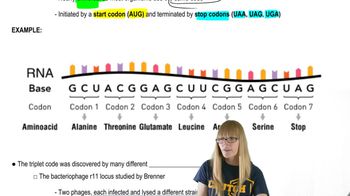Most proteins have more leucine than histidine residues, but more histidine than tryptophan residues. Correlate the number of codons for these three amino acids with this information.
Table of contents
- 1. Introduction to Genetics51m
- 2. Mendel's Laws of Inheritance3h 37m
- 3. Extensions to Mendelian Inheritance2h 41m
- 4. Genetic Mapping and Linkage2h 28m
- 5. Genetics of Bacteria and Viruses1h 21m
- 6. Chromosomal Variation1h 48m
- 7. DNA and Chromosome Structure56m
- 8. DNA Replication1h 10m
- 9. Mitosis and Meiosis1h 34m
- 10. Transcription1h 0m
- 11. Translation58m
- 12. Gene Regulation in Prokaryotes1h 19m
- 13. Gene Regulation in Eukaryotes44m
- 14. Genetic Control of Development44m
- 15. Genomes and Genomics1h 50m
- 16. Transposable Elements47m
- 17. Mutation, Repair, and Recombination1h 6m
- 18. Molecular Genetic Tools19m
- 19. Cancer Genetics29m
- 20. Quantitative Genetics1h 26m
- 21. Population Genetics50m
- 22. Evolutionary Genetics29m
11. Translation
The Genetic Code
Problem 21c
Textbook Question
In an experiment to decipher the genetic code, a poly-AC mRNA (ACACACAC...) is synthesized. What pattern of amino acids would appear if this sequence were to be translated by a mechanism that reads the genetic code as
A triplet without overlaps?
 Verified step by step guidance
Verified step by step guidance1
Understand the structure of the poly-AC mRNA sequence: The sequence alternates between adenine (A) and cytosine (C), forming a repeating pattern of ACACACAC...
Recognize that translation occurs in triplets (codons). Divide the sequence into consecutive groups of three nucleotides: For example, the first few codons would be ACA, CAC, ACA, and so on.
Consult the genetic code table to determine the amino acid specified by each codon. For example, ACA codes for threonine (Thr), and CAC codes for histidine (His).
Identify the repeating pattern of codons and their corresponding amino acids. Since the sequence alternates between ACA and CAC, the resulting amino acid sequence will alternate between threonine and histidine.
Conclude that the translation of the poly-AC mRNA sequence will produce a polypeptide with a repeating pattern of amino acids: threonine (Thr) and histidine (His).
 Verified video answer for a similar problem:
Verified video answer for a similar problem:This video solution was recommended by our tutors as helpful for the problem above
Video duration:
1mPlay a video:
Was this helpful?
Key Concepts
Here are the essential concepts you must grasp in order to answer the question correctly.
Genetic Code
The genetic code is a set of rules that defines how the sequence of nucleotides in mRNA is translated into amino acids, the building blocks of proteins. It consists of codons, which are groups of three nucleotides that correspond to specific amino acids or stop signals during protein synthesis.
Recommended video:
Guided course

The Genetic Code
mRNA Translation
mRNA translation is the process by which ribosomes read the sequence of an mRNA molecule to synthesize a corresponding polypeptide chain. This process involves the decoding of codons in the mRNA, where each triplet of nucleotides specifies a particular amino acid, leading to the formation of a protein.
Recommended video:
Guided course

Translation initiation
Triplet Codon Reading
Triplet codon reading refers to the mechanism by which the ribosome interprets the mRNA sequence in sets of three nucleotides, or codons, without overlapping. This means that each codon is read independently, allowing for a clear and systematic translation of the genetic information into a sequence of amino acids.
Recommended video:
Guided course

The Genetic Code
Related Videos
Related Practice
Textbook Question
590
views


